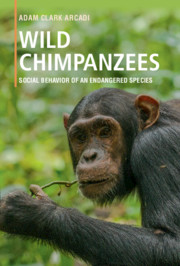Book contents
- Wild Chimpanzees
- Wild Chimpanzees
- Copyright page
- Dedication
- Contents
- Preface
- 1 Primates, Apes, and the Study of Chimpanzee Social Behavior
- 2 Seven Long-Term Field Studies
- 3 Chimpanzee Fission–Fusion Social Organization and Its Conservation Implications
- 4 Sex Differences in Ranging and Association Patterns
- 5 Female Social Relationships
- 6 Male Social Relationships
- 7 Sexual Behavior: Conflicting Strategies of Males and Females
- 8 Coalitionary Lethal Aggression between and within Communities
- 9 Hunting, Eating, and Sharing Meat
- 10 Communication: The Form and Content of Signals
- 11 Community Differences in Grooming Postures and Tool Use: Innovation, Social Learning, and the Question of “Culture”
- Epilogue
- Appendix: Field Methods for Studying Wild Chimpanzees
- End Notes
- References
- Index
- Plate Section (PDF Only)
8 - Coalitionary Lethal Aggression between and within Communities
Published online by Cambridge University Press: 01 June 2018
- Wild Chimpanzees
- Wild Chimpanzees
- Copyright page
- Dedication
- Contents
- Preface
- 1 Primates, Apes, and the Study of Chimpanzee Social Behavior
- 2 Seven Long-Term Field Studies
- 3 Chimpanzee Fission–Fusion Social Organization and Its Conservation Implications
- 4 Sex Differences in Ranging and Association Patterns
- 5 Female Social Relationships
- 6 Male Social Relationships
- 7 Sexual Behavior: Conflicting Strategies of Males and Females
- 8 Coalitionary Lethal Aggression between and within Communities
- 9 Hunting, Eating, and Sharing Meat
- 10 Communication: The Form and Content of Signals
- 11 Community Differences in Grooming Postures and Tool Use: Innovation, Social Learning, and the Question of “Culture”
- Epilogue
- Appendix: Field Methods for Studying Wild Chimpanzees
- End Notes
- References
- Index
- Plate Section (PDF Only)
Summary
OVERVIEW
Although occasional deaths resulting from fights between individuals have been observed across a wide range of species, coalitionary lethal aggression is common in only a few mammal taxa. It is comparatively frequent in several species of social carnivores and especially well documented in wolves. With the exception of chimpanzees and humans, it is rare among primates. In those species in which it occurs, coalitionary killing typically involves overwhelming superiority in numbers, such that victims are easily overpowered and attackers are at minimal risk of injury. Accordingly, two prerequisites, both met in chimpanzees, appear necessary for the emergence of coalitionary lethal aggression in the behavioral repertoire of a species: the ready formation of coalitions in general and a pattern of ranging in which groups of individuals with the potential to form coalitions regularly encounter isolated conspecifics.
Killings have been observed at all long-term chimpanzee field sites. Isolated adults and older adolescents are typically overwhelmed by multiple aggressors acting in concert. Victims are often forcibly pinned to the ground during attacks, while attackers inflict internal and external wounds by beating them with their hands, stomping on them with their feet, tearing flesh from limbs, and biting all parts of the body, including the testicles of male victims, which are often thus removed. Attacks tend to be prolonged, sometimes lasting more than twenty minutes, and victims eventually cease to resist, apparently entering a state of shock as attacks continue. Adult deaths from inflicted wounds may occur minutes, hours, or a few days after aggressors depart. Infants and dependent juveniles, by contrast, may be grabbed from their mothers and more quickly killed with bites to the head or abdomen. Infants are often eaten.
As of 2014, 152 killings, of which fifty-eight were directly observed, had been reported from fifteen communities. At Gombe, lethal intraspecific aggression is the second most common cause of mortality, behind disease, accounting for seventeen of eighty-six (19.8 percent) deaths with a known cause as of 2008. Although there is considerable variation across chimpanzee communities, median mortality rates from violent aggression rival those reported for smallscale hunter-gatherer and subsistence farming human societies.
- Type
- Chapter
- Information
- Wild ChimpanzeesSocial Behavior of an Endangered Species, pp. 65 - 79Publisher: Cambridge University PressPrint publication year: 2018



